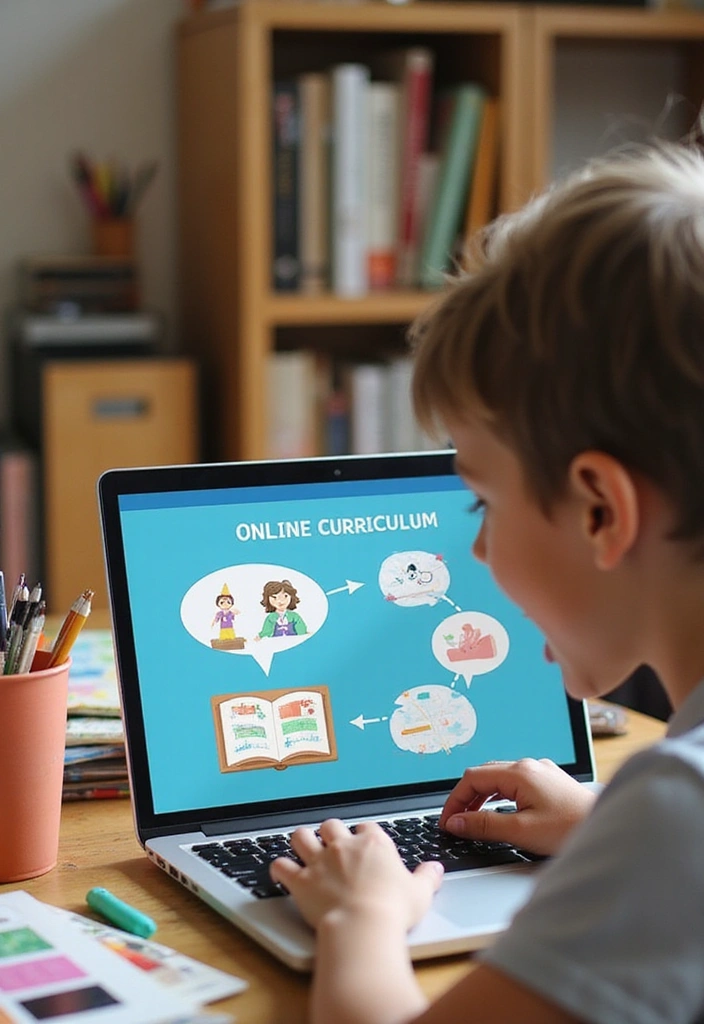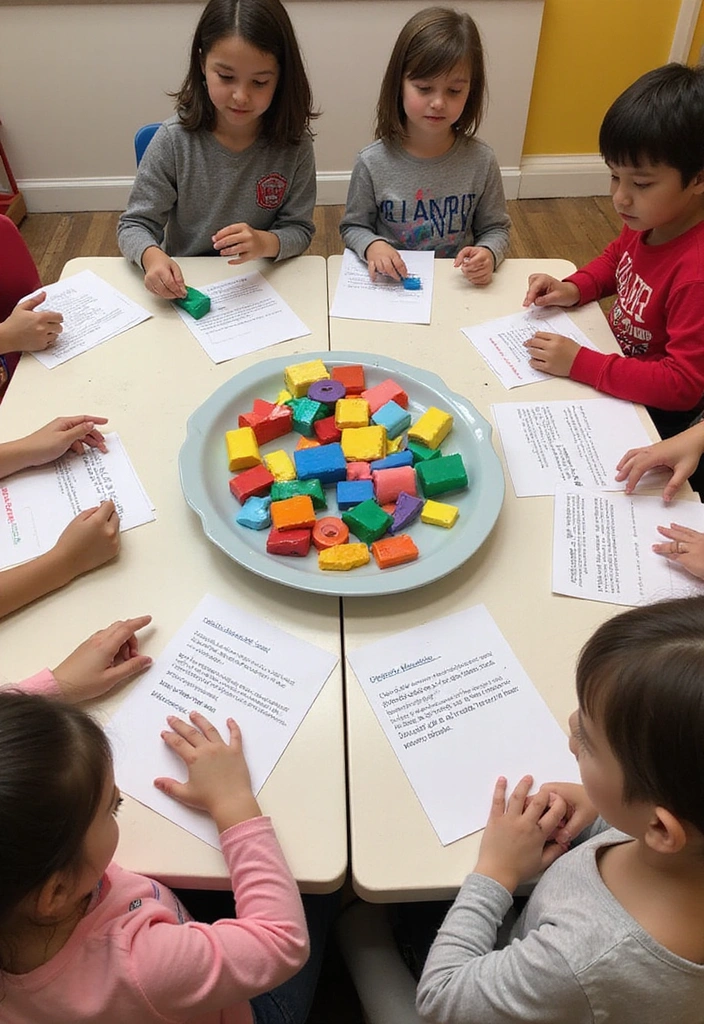Transform your learning journey! Discover 20 truly amazing homeschool resources you never knew you needed to make education easier and more engaging. Prepare to be wowed by resource #11!

Homeschooling can be an exciting journey, filled with endless opportunities for creativity and learning.
Whether you’re just starting out or looking to enhance your existing approach, discovering the right resources can make all the difference.
From engaging curriculums to flexible tools, we’ve rounded up 20 incredible homeschool resources that not only enrich education but also accommodate the unique needs of your family.
Buckle up, because you won’t want to miss #11—it’s a game changer!
1. Interactive Online Curriculum

The world of online learning has exploded, and interactive curriculums are leading the charge.
Websites like Khan Academy and ABCmouse offer engaging, game-like lessons that keep kids motivated. Plus, these platforms adapt to your child’s pace, allowing for a personalized learning experience.
Here are some benefits of interactive curriculums:
– Engagement: Kids are more likely to stay focused when learning feels like play.
– Flexibility: Tailor lessons to your child’s interests and abilities.
– Instant Feedback: Children can see their progress immediately, boosting their confidence.
With countless subjects available, it’s easier than ever to find the right fit for your child’s learning style.
2. Virtual Field Trips

Take learning beyond the four walls of your home with virtual field trips!
Museums, historical sites, and even science labs around the world offer online tours that can spark curiosity and excitement. Sites like Google Arts & Culture provide access to thousands of galleries and exhibits.
Benefits of virtual field trips include:
– Global Access: Visit anywhere in the world without leaving your home.
– Cost-Effective: No need for travel expenses, just an internet connection.
– Diverse Learning: Exposure to different cultures and ideas enhances your child’s education.
Virtual field trips can be a fantastic supplement to your curriculum, making lessons come alive.
3. Hands-On Science Kits

Bring science to life with hands-on kits that allow kids to experiment and explore.
Companies like KiwiCo and MEL Science provide monthly subscription boxes packed with projects that encourage critical thinking and creativity. These kits range from simple experiments to complex engineering challenges, which can cater to a variety of ages.
Why hands-on kits are awesome:
– Real Application: Kids learn scientific concepts through practical application.
– Encourages Curiosity: Experimenting fosters a love for discovery and inquiry.
– Collaborative Learning: Projects can be a family activity, promoting teamwork.
Hands-on science kits transform abstract concepts into concrete experiences, making learning unforgettable.
4. Educational Apps

In our tech-savvy world, educational apps can be a powerful ally in homeschooling.
Apps like Duolingo for language learners or Prodigy for math practice turn studying into a fun game. These digital tools are designed to keep children engaged while reinforcing important skills.
Consider these advantages of educational apps:
– Accessibility: Learning can happen anywhere, anytime, making it flexible.
– Variety of Content: A vast array of subjects makes finding the right app easy.
– Progress Tracking: Many apps offer analytics to help you monitor your child’s growth.
Integrating educational apps into your routine can enhance traditional learning methods, creating a balanced approach.
5. Nature Journaling

Encourage a love for the great outdoors with nature journaling.
This resource combines elements of science, art, and writing, allowing kids to document their observations and experiences in nature. All you need is a simple notebook and some colored pencils or watercolors!
Here’s why nature journaling is beneficial:
– Observation Skills: Children learn to notice details and patterns in nature.
– Creativity: Mixing art with science ignites imagination.
– Mindfulness: Spending time outdoors fosters a sense of peace and connection to the environment.
Nature journaling can be a beautiful way to explore the world while also enhancing a child’s educational journey.
6. Subscription Boxes

Subscription boxes have become a popular homeschooling resource, offering monthly surprises that engage kids in various subjects.
Whether it’s art supplies, STEM projects, or even books, these curated boxes bring fresh material to your door. Companies like Bookroo and Little Passports provide age-appropriate content delivered monthly.
Here’s what makes subscription boxes special:
– Variety: Each month introduces new themes and projects, keeping learning exciting.
– Convenience: No need to plan ahead; the work comes directly to you.
– Encouragement: Unboxing creates anticipation, making kids eager to learn.
Subscription boxes can be an excellent way to supplement your curriculum and keep things interesting.
7. Audiobooks and Podcasts

Audiobooks and podcasts are fantastic resources that can enrich your homeschooling experience.
They can help improve listening skills, comprehension, and vocabulary while providing entertainment and knowledge. Services like Audible or podcasts aimed at kids offer a wide range of content.
Key benefits include:
– Flexibility: You can listen while doing chores, driving, or during quiet time.
– Diverse Content: Topics vary widely, catering to different interests and age groups.
– Accessibility: Audiobooks are great for visual learners who may struggle with traditional reading.
Incorporating audiobooks and podcasts into your routine can provide a fresh, engaging way to learn.
8. Community Co-ops

Joining a local homeschooling co-op can be a game changer for both parents and kids.
These groups offer opportunities for shared classes, socialization, and support. Parents can take turns teaching subjects, bringing their unique skills to the table.
Why co-ops are beneficial:
– Social Interaction: Kids gain friendships and learn to work with others.
– Resource Sharing: Parents can exchange tips and materials, easing the workload.
– Diverse Learning Experiences: Exposure to different teaching styles enhances education.
Participating in a co-op can create a supportive community that enriches your homeschooling journey.
9. Creative Writing Prompts

Boost creativity with fun and engaging writing prompts that inspire children to express themselves.
You can find books filled with prompts or use websites that offer new ideas regularly. Encourage your child to write stories, poems, or even create comic strips!
Benefits of creative writing include:
– Imagination Stimulation: Prompts help spark creativity and new ideas.
– Improved Writing Skills: Regular practice enhances writing abilities.
– Emotional Expression: Writing can be a therapeutic way to process feelings.
Incorporating creative writing into your homeschool routine can help children develop their voice and storytelling skills.
10. Online Learning Communities

Connecting with like-minded families through online learning communities can provide valuable support and resources.
Websites and forums dedicated to homeschooling allow parents to share experiences, curriculum recommendations, and even organize group activities.
Advantages of these communities include:
– Support Network: Find encouragement and advice from fellow homeschooling parents.
– Resource Sharing: Discover new materials, tips, and tricks to enhance your journey.
– Interactive Learning: Participate in online events, discussions, or shared lessons.
Being part of a learning community can make homeschooling less isolating and more enjoyable.
11. Life Skills Learning

Homeschooling provides a unique opportunity to integrate life skills into your curriculum.
From cooking to budgeting, teaching kids practical skills is essential. You can create projects or lessons around everyday tasks, helping children learn through real-world applications.
Why life skills are important:
– Independence: Kids gain confidence in their ability to handle everyday challenges.
– Problem-Solving: Navigating real-life situations enhances critical thinking.
– Responsibility: Managing tasks fosters a sense of accountability.
Teaching life skills alongside traditional subjects creates well-rounded learners prepared for adult life.
12. Educational Videos

There are countless educational videos available on platforms like YouTube and streaming services that can complement your teaching.
From science experiments to history lessons, these videos can make complex topics easier to understand. Plus, they cater to various learning styles, making education more accessible.
Benefits include:
– Visual Learning: Helps visual learners grasp concepts more effectively.
– Engagement: Dynamic content keeps kids interested and entertained.
– Diverse Perspectives: Access to various educators and viewpoints enriches learning.
Incorporating educational videos into your homeschool routine can provide a refreshing approach to traditional learning.
13. Local Library Resources

Your local library is a treasure trove of homeschool resources waiting to be explored.
From books and DVDs to workshops and events, libraries often offer free access to a wealth of knowledge. Most libraries also have programs specifically for homeschool families, including storytime and science fairs.
Here’s why libraries are invaluable:
– Free Access: Borrowing materials is cost-effective and encourages reading.
– Community Events: Participate in local homeschooling events and connect with others.
– Resource Variety: Access to diverse materials supports a range of subjects and interests.
Utilizing your library can expand your educational resources and inspire a love for learning.
14. Flexible Learning Schedules

One of the greatest benefits of homeschooling is the flexibility it provides.
You can create a schedule that fits your family’s unique rhythms and requirements. This might mean adjusting lessons based on energy levels, interests, or family commitments, making learning more enjoyable.
Consider these aspects of flexible learning:
– Customization: Tailor the schedule to when your child is most focused and energetic.
– Family Time: Blend family activities into learning, reinforcing bonds.
– Adaptability: Adjust plans based on unexpected events or interests.
Embracing flexibility can lead to a more relaxed and effective homeschooling experience.
15. Art and Creativity Resources

Art and creativity play crucial roles in a well-rounded education.
Incorporating art into your homeschool routine can help children express themselves and develop critical thinking skills. Resources like online art classes, craft kits, and local art workshops can make learning fun.
Here are the advantages of prioritizing art:
– Self-Expression: Encourages children to communicate their thoughts and feelings.
– Skill Development: Fosters fine motor skills and hand-eye coordination.
– Cultural Awareness: Exposure to various art forms promotes understanding and appreciation.
Integrating art into your curriculum can enrich your child’s learning experience.
16. Math Manipulatives

Math can be made much more accessible and enjoyable with the help of manipulatives.
Using tools like blocks, counters, and games can help children grasp complex concepts in a hands-on way. They can build a strong foundation in math by exploring each concept practically.
Benefits of using manipulatives include:
– Concrete Understanding: Physical objects help children visualize abstract ideas.
– Engagement: Hands-on learning keeps kids interested and motivated.
– Problem-Solving Skills: Manipulatives encourage experimentation and critical thinking.
Incorporating math manipulatives into your teaching can make math fun and approachable.
17. Time Management Tools

Teaching kids how to manage their time effectively is a vital skill for success in schooling and life.
Using planners, timers, and visual schedules can help children learn to prioritize tasks and develop a sense of responsibility. These tools can make learning more structured and less overwhelming.
Reasons time management tools are important:
– Organization: Helps kids keep track of assignments and deadlines.
– Focus: Timers can improve concentration and work efficiency.
– Independence: Children learn to take ownership of their schedules.
Implementing time management strategies can empower your child to become more self-sufficient.
18. Creative Cooking Lessons

Cooking is an excellent way to teach kids about math, science, and health in a fun and tasty way.
Involving children in meal preparation not only teaches them essential life skills but also encourages them to make healthier choices. You can turn cooking into a fun educational activity!
Benefits of creative cooking lessons:
– Math Skills: Measuring ingredients practices math in real-life scenarios.
– Science: Cooking involves chemical reactions and concepts that spark curiosity.
– Healthy Eating: Kids learn about nutrition and the importance of balanced meals.
Incorporating cooking into your curriculum can provide delicious opportunities for learning.
19. Gardening as a Learning Tool

Gardening offers a unique and practical way to teach subjects like biology, ecology, and nutrition.
By engaging kids in gardening, they learn about plant life cycles, responsibility, and the importance of healthy eating. Plus, it gets them outdoors!
Advantages of using gardening as a learning tool:
– Hands-On Learning: Kids experience nature firsthand, enhancing understanding.
– Responsibility: Caring for plants teaches commitment and accountability.
– Sustainability: Understanding where food comes from can inspire environmentally conscious choices.
Integrating gardening into your homeschooling can cultivate a love for nature and science.
20. Family Game Nights

Family game nights are not only fun but can also be educational.
Games that encourage critical thinking, strategy, and teamwork can enhance various subjects like math, history, and language arts. You can rotate board games with educational value into your weekly routine!
Here’s what makes game nights special:
– Engagement: Games captivate kids’ attention and foster motivation to learn.
– Quality Time: Family bonding strengthens relationships and creates lasting memories.
– Learning Through Play: Children often absorb knowledge better when having fun.
Incorporating game nights can add a valuable social element to your homeschooling experience.
Final Words

With so many incredible homeschool resources out there, the possibilities for creative and engaging education are endless.
From interactive online curriculums to hands-on projects, each resource offers a unique way to customize your child’s learning experience.
Embrace the journey, and enjoy the flexibility and creativity that homeschooling provides. Don’t forget to share your favorite resources with fellow homeschooling families!







